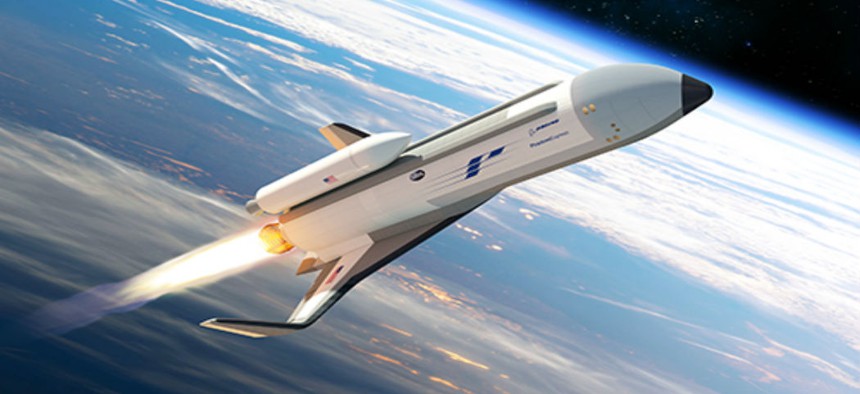
Boeing to demo DARPA space plane
The XS-1 hypersonic vehicle would demonstrate cheaper, quick-turnaround satellite launches to low-Earth orbit.
Boeing will build and demonstrate a prototype of a new class of hypersonic aircraft designed to provide quick access to low-Earth orbit.
The Defense Advanced Research Projects Agency selected Boeing's design for the next "fabrication" and "flight" phases of its Experimental Spaceplane-1 (XS-1) effort. The DARPA program seeks to create a "launch-on-demand" capability for smaller payloads while lowering launch costs by a factor of 10.
The reusable XS-1 would serve as a hybrid aircraft-space launcher capable of lifting payloads to the edge of space where an expendable upper stage would place satellites up to 3,000 pounds into polar orbits.
Launched like a rocket and powered by cryogenic propellants, program officials said the XS-1 space plane would reach hypersonic speeds before releasing its upper stage. The reusable first stage would then land on a runway to be readied for its next flight "within hours," DARPA said.
"Demonstration of aircraft-like, on-demand, and routine access to space is important for meeting critical Defense Department needs and could help open the door to a range of next-generation commercial opportunities," Brad Tousley, director of DARPA’s Tactical Technology Office, which oversees XS-1, noted in a May 24 statement announcing the Boeing design win.
Phase 2 of the program calls for Boeing's Phantom Works unit, which also builds the X-37B space plane used for classified Air Force missions, to design and test a prototype vehicle by 2019. The initial tests include firing the prototype vehicle's engines 10 times in 10 days to verify its propulsion system is ready for flight tests. The XS-1 will use an Aerojet Rocketdyne AR-22 engine, a version of the U.S. space shuttle main engine.
Flight testing of the XS-1 is scheduled to begin in 2020, with up to 15 sorties that would also include 10 test flights over 10 days, DARPA said. Initial flights without a payload would reach speeds up to Mach 5. Later flights would top out at Mach 10 and eventually deliver a demonstration payload to orbit.
Along with lightweight composite cryogenic propellant tanks, the XS-1 demonstration phases will evaluate the ability of composite-metallic wings and control surfaces to withstand the pounding of suborbital hypersonic flight along with temperatures of more than 2,000 degrees Fahrenheit.
Pamela Melroy, a former shuttle commander who also served as deputy director of DARPA’s Tactical Technology Office, noted that XS-1 and related efforts are designed to get a handle on launch and satellite costs. "The cost of access to space is one of our major focus areas," Melroy stressed.
DARPA also said XS-1 testing will wring out its Airborne Launch Assist Space Access program, which seeks to launch 100-pound satellites into low-Earth orbit on short notice for less than $1 million per launch. That effort reflects the research agency's plans to develop smaller, cheaper satellites that could be replaced more quickly than current payloads launched using expendable rockets.
Also competing for the next phase of the XS-1 program were the teams of Northrop Grumman and Virgin Galactic along with Masten Space Systems and XCOR Aerospace.
Boeing's prototype dubbed "Phantom Express" measures 100 feet in length with a wingspan of 62 feet. The single AR-22 engine would burn a mixture of liquid hydrogen and oxygen.
"Phantom Express is designed to disrupt and transform the satellite launch process as we know it today, creating a new, on-demand space-launch capability that can be achieved more affordably and with less risk,” Darryl Davis, president, Boeing Phantom Works, noted in a statement.

